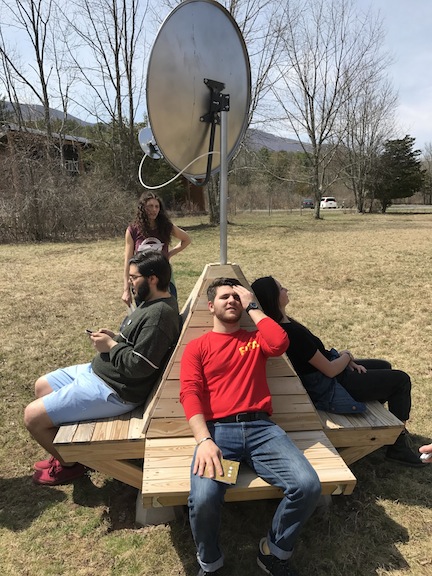Community and Radio class visits Wave Farm
When Visiting Assistant Professor Adam Tinkle’s “Community and Radio” class departed
campus in the Skidmore minivan on April 25, the car was filled not with the sounds
of an iPod or Spotify. Instead, the sound came over radio waves. Driving south, as
radio signals faded in and out, the class was treated to a firsthand demonstration
of the spatial nature of radio broadcasting.
The destination was Wave Farm, a nonprofit arts organization that facilitates and
broadcasts transmission arts based in Acra, New York. As we approached the property,
we tuned the radio to pick up Wave Farm’s broadcasting frequency, WGXC 90.7, and we
could sense we were close. The station was broadcasting a minimal and pensive piano
composition unlike anything you’d expect to hear on mainstream radio.
 Wave Farm began in 1997 as a pirate radio collective called “free103point9.” The low-power
station engaged with performance and experimental sound, soon forming a community
of artists who thought conceptually about transmission as a creative medium. The group
was seminal in cultivating a practice of transmission arts, which they define as “a
multiplicity of practices that engage aural and visual broadcast media, where in some
instances works for traditional broadcast are created, and at other times artists
harness, or create, transmissions for manipulation in live performance, installation
and public interactive networks and tools.”
Wave Farm began in 1997 as a pirate radio collective called “free103point9.” The low-power
station engaged with performance and experimental sound, soon forming a community
of artists who thought conceptually about transmission as a creative medium. The group
was seminal in cultivating a practice of transmission arts, which they define as “a
multiplicity of practices that engage aural and visual broadcast media, where in some
instances works for traditional broadcast are created, and at other times artists
harness, or create, transmissions for manipulation in live performance, installation
and public interactive networks and tools.”
In 2005, the group moved to a 29-acre farm where they could facilitate an artist residency
program, host live performances and create a network of long-term outdoor installations.
When the class arrived at the Wave Farm property, there were children riding bikes
and playing in the yard. We were greeted and given a tour of the property by Galen
Joseph-Hunter, the executive director of Wave Farm and co-founder of free103point9.
The grounds have a staggering amount of unique installations—such as an old school
fire truck that transmits on AM and a synthesizer that creates sound based on weather
readings.
The class was fortunate to meet one of the former artists-in-residence, Zach Poff,
as he was making modifications to an installation he had built in 2015. The “pond
station” is a device that floats on the surface of a pond on the property and transmits
sounds from under the surface of the water 24 hours a day. Poff was in the process
of making the station more turtle-proof, since some turtles had recently grown an
appetite for the Styrofoam floatation.
After getting a glimpse of Wave Farm’s unique organization and mission, the class
headed east to Hudson, where the main studio space for WGXC is located. There the
class met with the manager of the station, Lynn Sloneker, who spoke about WGXC’s distinct
programming structure and what it means to be a radio station by the community and
for the community.
After the conversation, the class took some time to explore Hudson, piled into the
car and trucked back up to Skidmore. The visit gave students an opportunity to witness
a singular and experimental take on radio transmission and also how this approach
can be effectively incorporated into community-oriented radio broadcasting.
Adam Simon '19 is a philosophy major who likes to play music with friends, spend time in nature and make his cat chase things on a string. He is fascinated by the social and emotional impact of storytelling and how this can be explored in abstract, experimental and personal ways.
